- Home
- Raymond Benson
High Time To Kill Page 6
High Time To Kill Read online
Page 6
Taylor Harris’s mug shot filled the screen. He had a shaved head and a swastika tattooed on his forehead. “In early 1995, at age thirtysix, Harris founded a small militia group who proclaimed themselves white supremacists. After the local authorities arrested several of his members during a rally that turned violent, he was run out of the state. Harris traveled to Europe and the Middle East, then came back to Oregon with a large amount of capital six months later. He had apparently gone into business with foreign investors located either in the Middle East or North Africa. With this funding, he created the Union, which certain specialist magazines touted to be a freelance mercenary outfit. Qualified men with proper military training could get a high-paying job with the Union—as long as they were willing to travel, be discreet, and show that they had the stuff. The ‘stuff,’ it turned out, was having the ability to commit murder, arson, burglary, kidnapping, and other serious crimes.”
The visuals changed to a grainy black and white film of men in fatigues doing push-ups on a field, running around a track, shadow boxing.… “The ad campaign lasted six months, and men from all over the world joined the Union. This film of early trainees was confiscated during a raid, on the Union’s Oregon headquarters in December 1996. The American authorities became aware of their activities after Taylor Harris was gunned down in a restaurant in Portland, Oregon, a month earlier.”
The screens filled with police photographs of Taylor Harris, lying on the floor in a pool of blood and spaghetti.
“It is believed that Harris was murdered by his lieutenants, all of whom fled the country. Prior to this incident, no Union ‘jobs’ had ever been reported. Recruiting advertisements disappeared after the raid, and it appeared that the Union had been only a crazy whim of a deranged ex-Marine.”
Maps of the world popped up on the screen. “The truth became clear in 1997 as evidence began to surface that former Union members were involved in terrorist-style operations. It is believed that unknown foreigners now control the Union, and that they are managed as an underground, networked organization. Recruitment occurs only by word of mouth. SIS is convinced that the Union already have a strong base of tough, talented men. To date, this group of criminals and mercenaries have struck around the world half a dozen times. Besides hiring themselves out to countries and governments, members often initiate their own projects in the hope that they might prove to be profitable later.”
The camera focused on the Mediterranean. “The Union are a rapidly growing network of tough professionals, and it is believed that they are coordinated from somewhere in the Mediterranean region. It is estimated that there may be as many as three hundred Union members worldwide.”
A man’s silhouette was superimposed over the map, and a big question mark hung over his head. “The Union boss is thought to be a businessman, very wealthy and very powerful. Likely suspects are Taylor Harris’s three lieutenants, all of whom fled the United States after his murder and are wanted for that crime. They are”—the monitor lingered on mug shots of the three men—“Samuel Loggins Anderson, age thirty-five, ex-Marine and former insurance salesman.” He was bald, had long sideburns and crooked teeth.
“James ‘Jimmy’ Wayne Powers, age thirty-three, former National Guardsman who spent time in jail for armed robbery.” He was thin, and had large dark eyes and black hair.
“And Julius Stanley Wilcox, age thirty-six, another ex-Marine and former forest ranger.” Wilcox was the ugliest and meanest-looking, with a scar above his right eye, a hawk nose, and greasy, slicked-back gray hair.
“None of these three men has been seen since they left the United States.”
A flowchart appeared on the monitor. “Like the Mafia, the Union are run by a manager or president whom they call Le Gérant. Beneath him are three or four trusted lieutenants—all men high in hierarchy who each control a vast worldwide network of murderers, arsonists, safe-crackers, loan sharks, prostitutes, mercenaries, and blackmailers.”
Bond clicked on the “projects” button.
Another mug shot flashed on the screen. He was a small man with fear in his eyes. “This is Abraham Charles Duvall. He was arrested in Washington, D.C., after the armed robbery of the Georgetown Savings and Loan in April 1997. He kept telling authorities that he was ‘Union,’ and that he would never go to jail. An ‘uncle’ posted bail, and Duvall was never seen again. Washington, D.C., police later received a notice from individuals claiming responsibility for the robbery. They called themselves ‘the Union.’ ”
The image on the monitor changed to that of a newspaper front page. The photograph below the headline featured American soldiers carrying a wounded man on a stretcher. “Rumors that the Union was a real organization were not taken seriously by Interpol until a car bomb killed several American soldiers in Saudi Arabia in mid-1997. What was first dismissed as a political attack on the West was later revealed to be the work of a group of individuals hired by the Libyan government. Four suspects were killed when authorities attempted to arrest them. They put up a fierce fight, and one of the dying men had this to say—”
Low-quality video footage showed an Arab in fatigues lying in the dusty street of a North African village. A medic was tending to his wounds, which appeared to be massive. The cameraman asked the man something unintelligible, but the Arab’s answer was quite clear: “I am proud to die for the Union.”
“Even though some members have been arrested, thus far the Union have been successful at every crime they have committed and claimed responsibility for. The world’s law enforcement agencies now take the Union very seriously. It appears that they have an uncanny ability to infiltrate legitimate intelligence organizations. One of the Union’s most notorious achievements was recruiting a mole in the Central Intelligence Agency.”
A mug shot of a man with glasses and a pockmarked face flashed on the screen. “Norman Nicholas Kalway, a midlevel official at the CIA, was caught red-handed with classified documents. It was learned that he had provided over ten million dollars’ worth of data to the Union. His story was that he had been blackmailed by the organization with evidence of unusual and felonious sexual practices (all of which came out publicly after Kalway was caught). Whether the CIA agent was a victim or not, his case is indicative of the lengths that the Union will go to in order to ensnare workers.”
Another mug shot replaced Kalway’s, an attractive woman in her twenties, except that she had bruises on her face and hate in her eyes.
“The Mossad experienced a similar scandal when one of their agents, Katherine Laven, was found to be Union after she had poisoned her lover, Israeli cabinet member Eliahu Digar. Digar had a number of enemies, any one of whom might have tempted agent Laven with a large payoff to get rid of him. It was this case that alerted authorities to what has been called the Union’s ‘signature’ when it comes to assassinations. Apparently poisoning Mr. Digar wasn’t enough. After he had died, Miss Laven slit the man’s throat from ear to ear with an extremely sharp instrument. Other murders in which the victims’ throats were cut in this manner have been reported as being Union-related.”
Bond was familiar with all of the Union’s alleged cases. He clicked back to the “projects” menu and clicked on the most recent addition. The picture changed again to that of Bond’s friend.
“The latest notch on the Union’s board is the March 1999 assassination of the former governor of the Bahamas.”
The photo was replaced by one of the Bahamian man who had cut the governor’s throat. “Lawrence Littleby, aged twenty-seven, was responsible for the murder. He was a troublemaker who had been in and out of the local jails on various misdemeanors. He had most likely been approached with the lure of a sizable amount of money. Investigators found ten thousand U.S. dollars hidden in the man’s bedroom.”
Bond clicked out of “projects” and clicked on the “exit” button.
The visuals became a full-motion montage of newspaper headlines, news photos, and newsreel footage of soldiers in various forms of co
mbat. “We believe that the Union have become more powerful in the last year. When they cannot buy someone’s services, they find other, less pleasant means to persuade them to work. They are experts at everything from petty street crime to elaborate espionage schemes. It cannot be stressed enough that the Union should never be underestimated and that they should always be considered extremely dangerous.”
The presentation ended. Bond thought of his old enemies, SPECTRE. They were a lot like the Union. They had been interested only in making money, and Ernst Stavro Blofeld had run the cabal with the efficiency of a corporation. The Union were different in that their tactics were more guerrilla oriented. SPECTRE had gone for grand, world-shaking events. The Union weren’t particular in the jobs they performed. There was no social status or class prejudices in the Union. It was one of the keys to their success in recruiting members.
The phone by the keypad buzzed. Bond picked it up. “Yes?”
It was Miss Moneypenny. “James, I thought you were in there. You’re wanted in the Briefing Room at eleven hundred sharp.” Bond glanced at his watch. It was 10:50.
“Nothing like twenty-four hours’ notice, Penny,” he said.
“Never mind that. This is serious. Some big brass will be sitting in. See you there.” She rang off and left Bond to ponder the empty, dark monitor in front of him. He sighed heavily, gathered his materials, punched the keypad so that a complete printout of the Union presentation would be delivered to his office, then left the Visual Library and took the lift to the top floor.
The place was buzzing with activity. Secretaries were rushing back and forth and phones were ringing. Bond caught up with Miss Moneypenny, who was walking fast and carrying a stack of folders toward the briefing room.
“What the hell is going on?” Bond asked.
“M declared a Code Three a few minutes ago, James. You had better get in there. The Minister of Defence and a lot of military brass are here.”
“Someone probably lost a contact lens,” Bond muttered, and went into the room.
The Briefing Room could easily sit a hundred people or more. Similar to the Situation Room, it contained large screens on the walls for multimedia presentations, rows of school-type chairs with attached desktops arranged in a semicircle facing the podium, and an abundance of electronic equipment. Bond eased into the room and found a place near the end of a row of chairs. Looking around, he was surprised to see some of the people there.
M was quietly conversing with the Minister of Defence near the podium. Bill Tanner was standing by, awaiting instructions. Occupying the other chairs were various top staff members such, as Head of S., Head of Records, and Head of Counterintelligence. There were several visitors next to them, including Air Marshal Whipple, the head of MI5, and none other than Group Captain Roland Marquis.
Tanner called the meeting to order. “Ladies and gentlemen, the Minister of Defence wishes to address you first.”
The Minister took the stand and cleared his throat. “Last night an act of industrial espionage and terrorism was committed against our country. A top secret formula for a hot plasma bonding process known as Skin 17 was stolen from one of the DERA’s secret research facilities in Fleet. It is of vital importance to Great Britain that we track down the individuals responsible for this and retrieve the formula. Christopher Drake, a director of the DERA, will explain further.”
The Minister relinquished the floor to Mr. Drake, a tall, distinguished man of fifty.
“Good morning. I’ve been asked to explain in layman’s terms what we at the DERA were developing for the RAF. It has been a longtime goal for the UK to be the first country in the world to develop an aircraft material that could withstand a speed of Mach 7. An as-yet-unattainable speed, Mach 7 is the Holy Grail in the aerospace industry. Now, we all know that the technology has existed for years to create the power to push a plane to that speed, and the materials exist to build an airplane. Think of it. The benefits to both civil and especially military aviation are self-evident. One could fly from London to New York in forty minutes—or bomb three countries in a half hour. Two years ago the Minister of Defence ordered us, along with the RAF, to develop a material that could stand up to the wear and tear that would occur at a speed of Mach 7.
“The problem has always been that at such a high speed mere atmospheric dust is sufficient to dent and tear the skin off the plane. The way around this dilemma is found in the science of fluid dynamics. An object traveling through a fluid creates around itself a boundary layer which essentially pushes the elements of the fluid out of the way, creating a ‘tunnel effect.’ It’s through this tunnel that the object travels relatively unimpeded. Turbulence issues abound in this science; the mathematics are extremely complicated; the engineering problems are bigger. The trick is to create ‘Smart Skin’ materials for the plane that would expand and alter this boundary layer, essentially forming the optimal aerodynamic configuration through which the plane would fly. This material would be a carbon-fiber and silica ceramic. But because carbon-fiber and silica do not easily bond, the DERA spent two years developing a hot plasma bonding process.”
Slides began to appear on the large screens. The first was a photo of Dr. Wood.
“Yesterday Dr. Thomas Wood, whom we hired to work on the project at our secret ware house in Fleet, successfully completed the formula—or so we believe. The DERA and the Britishmilitary establishment have kept this project top secret and we were quite eager to unveil the results—giving the UK a much-needed leg up, strategically speaking, over our allies and enemies. Commercially, it is worth billions.”
The slide changed to an exterior shot of the Fleet warehouse.
“Shortly after twenty-one hundred hours last night, someone infiltrated the lab in Fleet. The entire facility was burned to the ground. Records were destroyed and there was virtually nothing salvageable. We did unfortunately find the remains of Dr. Wood, who had been shot in the leg and in the head. All traces of Skin 17, the specification he created, have disappeared. The thieves were also successful in stealing backup copies of previous versions of the formula that were kept at the DERA facility in Farnborough, indicating that, I’m sorry to say, a DERA employee may have been involved in the crime. Unfortunately there are no other copies of this important work, which represents two years of intensive research and development. Needless to say, it is vital that no copies of the Skin 17 specification fall into the wrong hands.”
Tanner had inched along the wall and was now standing next to Bond’s seat.
“I assume this was the project you were referring to yesterday,” Bond whispered.
Tanner whispered back, “Uh-huh.”
The slide changed to a picture of Steven Harding.
“This is Dr. Steven Harding, who was serving as Dr. Wood’s righthand man. The rest of his team have been summoned back from various parts of the country and are here in this room. Dr. Wood had given them the day off yesterday because he wanted to make the final tests on the scalable prototype alone. We know that Wood left instructions for Dr. Harding to come to the lab at nine o’clock last night. Whether or not he did this is unknown, but we find it disturbing that Dr. Harding is missing. He is simply nowhere to be found.”
Bond whispered to Tanner, “Christ, we just played golf with him yesterday!”
“I know,” Tanner replied. “This is all very bizarre.”
Mr. Drake said, “I’d like to call to the stand Group Captain Roland Marquis, who was the RAF liaison to the ‘Smart Skin’ project.”
Marquis stood up and stiffly walked to the front of the room. “Before I field questions,” he said, “I want to say that I am extremely proud of the work Dr. Wood and his team did on this project. Great Britain has lost a national treasure in him. Now, Minister, M, distinguished colleagues, I am at your disposal.”
The Minister spoke first. “Group Captain, we understand that you saw Dr. Harding yesterday.”
“Yes, sir,” Marquis replied. “I played golf with him at
Stoke Poges. It was around seventeen hundred hours when we said good-bye and parted company.”
“Did he indicate to you what his plans were?”
“No, sir, I knew that Dr. Wood had given the team the day off, and that he was close to finishing Skin 17. Dr. Harding was quite eager to hear news from Dr. Wood. He made at least two phone calls from the club to find out what was going on. I knew that Dr. Harding would be visiting the lab later that evening, that is, last night. Other than that, he didn’t say much. He’s a professional and would never talk about the work outside the DERA complex, even with me.”
M asked, “How well do you know this Dr. Harding?”
“Not very well. I got to know him over the last two years during the normal day-to-day administrative work I did in supervising Skin 17. One day we discovered a mutual interest in golf. That’s all. Yesterday was the third time we had played together.”
“How close to the project were you?” she asked.
“I had no idea what they were actually doing, technically. I mean, I knew what their goal was and I knew generally how they were going about it. But I’m no physicist, ma’am. My job was to control the budget, make sure they had what they needed, and make monthly reports to my superiors in the RAF.”
“And you have no idea where Dr. Harding is now?”
“None, ma’am.”
“Do you think he is capable of doing something like this?”
Marquis paused a moment before answering. Finally, he said, “I don’t think so, ma’am. Dr. Harding always struck me as an introvert, a quiet type with a high intellect. I never once saw him get angry. I can’t imagine that he’d have a violent bone in his body, much less be a traitor to his country. He has no criminal record. I know that stranger things have happened in our government’s history with regard to spies and counterspies. Nevertheless, it is my opinion that Dr. Harding may have come to an untimely end, along with Dr. Wood.”

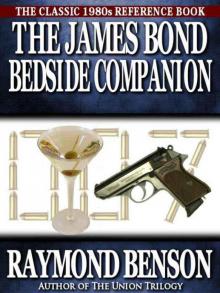 The James Bond Bedside Companion
The James Bond Bedside Companion The Black Stiletto's Autograph
The Black Stiletto's Autograph Blues in the Dark
Blues in the Dark Zero Minus Ten
Zero Minus Ten The Black Stiletto
The Black Stiletto Doubleshot
Doubleshot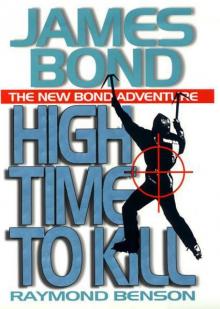 High Time To Kill rbb-3
High Time To Kill rbb-3 Bond Movies 07 - Die Another Day
Bond Movies 07 - Die Another Day The Facts Of Death
The Facts Of Death Midsummer Night's Doom
Midsummer Night's Doom Blast from the Past
Blast from the Past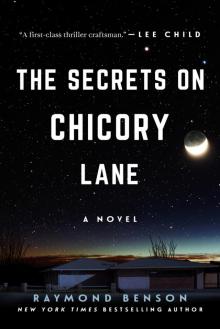 The Secrets on Chicory Lane
The Secrets on Chicory Lane High Time To Kill
High Time To Kill The Black Stiletto: Black & White
The Black Stiletto: Black & White The World Is Not Enough jb-1
The World Is Not Enough jb-1 Zero Minus Ten rbb-1
Zero Minus Ten rbb-1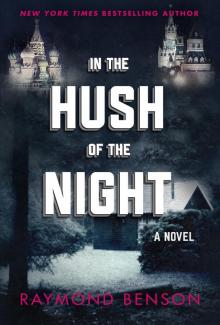 In the Hush of the Night
In the Hush of the Night The Black Stiletto: Stars & Stripes
The Black Stiletto: Stars & Stripes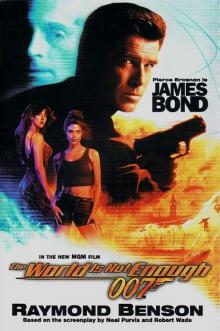 Bond Movies 06 - The World Is Not Enough
Bond Movies 06 - The World Is Not Enough The Rock 'n Roll Detective's Greatest Hits - A Spike Berenger Anthology
The Rock 'n Roll Detective's Greatest Hits - A Spike Berenger Anthology Never Dream Of Dying
Never Dream Of Dying